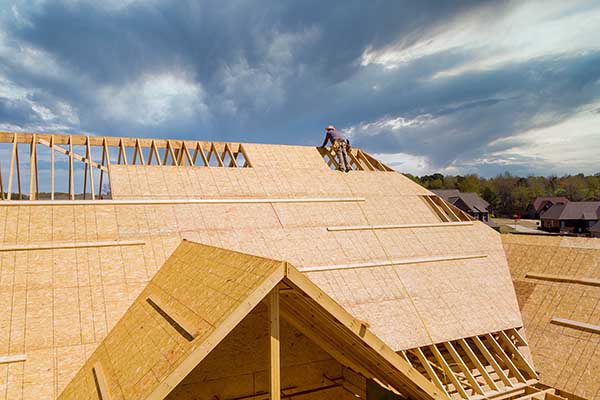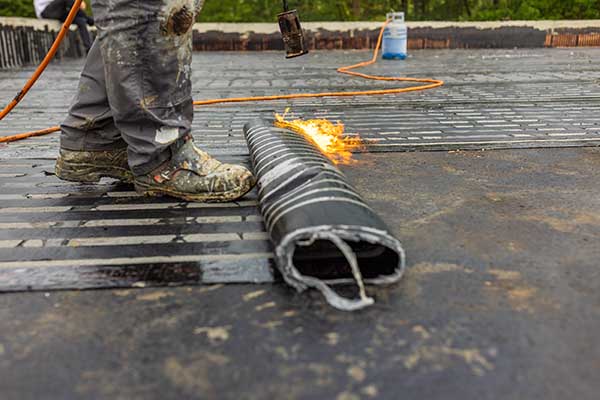Weatherproofing Your Commercial Roof: Preparing for Extreme Weather Events
Wright's Roofing & Construction, Inc.
Locally Owned • Free Estimates • 24/7 Emergency Service
Free Estimates
Protect Your Commercial Roofing from Extreme Weather
Extreme weather events are becoming more frequent and severe, posing a significant challenge for commercial property owners. Your roof is your building’s first line of defense against the elements, making it one of the most critical components to prepare and maintain. A well-weatherproofed roof not only protects your business from costly repairs but also ensures the safety of your employees, tenants, and customers.
This comprehensive guide will help you prepare your commercial roof for extreme weather events such as heavy rain, high winds, snow, and heatwaves. From preventative maintenance to choosing the right materials, we’ll explore actionable strategies to protect your property and keep your business running smoothly.
Why Weatherproofing Your Commercial Roof Matters
Weather-related roof damage can lead to significant issues, including:
- Water infiltration and leaks
- Structural damage to the building
- Mold and mildew growth
- Energy inefficiency
- Business interruptions and costly downtime
By taking proactive measures, you can minimize these risks, extend the lifespan of your commercial roofing, and reduce long-term maintenance costs. Whether you’re in a region prone to heavy rain or an area facing extreme heat, weatherproofing your roof is a vital investment.
Understanding Common Weather Challenges for Commercial Roofs
Before diving into preparation strategies, it’s important to understand the unique challenges posed to your commercial roofing by different weather conditions:
Heavy Rain and Flooding
- Risks: Water pooling, leaks, and saturation of roofing materials can compromise the integrity of your roof.
- Commonly Affected Roofs: Flat or low-slope roofs are particularly vulnerable to water pooling if drainage systems are inadequate.
High Winds
- Risks: Strong winds can dislodge roof membranes, flashing, and other components, leaving your roof exposed to further damage.
- Commonly Affected Roofs: Roofs with loose or improperly secured materials are at greater risk of wind damage.
Snow and Ice
- Risks: Snow accumulation and ice dams can create excessive weight on the roof and cause water damage when melted ice seeps into cracks.
- Commonly Affected Roofs: Buildings in colder climates with flat roofs or inadequate insulation are especially at risk.
Heatwaves and UV Exposure
- Risks: Prolonged heat and UV exposure can degrade roofing materials, causing cracks, blistering, and reduced energy efficiency.
- Commonly Affected Roofs: Dark roofs and older materials are more prone to heat-related damage.

Wrights Roofing & Construction, Inc.
Provided me with what I needed to cover my roof when it started leaking in multiple areas till I can get it fixed. They where there for me when no one else was. I recommend them 100% they great people who have a heart.
-Shaina B.
Steps to Weatherproof Your Commercial Roof
Now that you understand the risks, here’s how to prepare your commercial roof for extreme weather events.
1. Schedule Regular Roof Inspections
Routine inspections are the cornerstone of weatherproofing. A professional roofer can identify vulnerabilities and recommend solutions before problems escalate.
Frequency:
- At least twice a year (spring and fall)
- After major weather events such as storms or heavy snowfall
What to Look For:
- Cracks or tears in the roof membrane
- Ponding water or clogged drains
- Loose or damaged flashing
- Signs of wear, such as blistering or cracking
- Structural sagging or weak spots
Addressing these issues early can save you from costly repairs later.
2. Upgrade Your Drainage System
Effective drainage is critical for flat or low-slope commercial roofs, especially during heavy rain or snowmelt. Standing water can quickly deteriorate roofing materials and lead to leaks.
Steps to Improve Drainage:
- Install Additional Drains: Ensure your roof has enough drains to handle the expected rainfall in your area.
- Maintain Gutters and Downspouts: Regularly clean gutters and downspouts to prevent blockages.
- Use Scuppers: Scuppers help direct water off the roof and into drainage systems.
- Add Tapered Insulation: Tapered insulation can create slight slopes on flat roofs, improving water runoff.
3. Secure and Reinforce Roofing Materials
Strong winds can wreak havoc on loose roofing components. Take the following steps to reinforce your roof and minimize wind damage:
Best Practices:
- Inspect Fasteners: Ensure all fasteners, screws, and adhesives are secure.
- Reinforce Flashing: Properly secure flashing around vents, skylights, and HVAC units to prevent wind uplift.
- Seal Edges: Seal roof edges and seams with high-quality adhesives to reduce the risk of material displacement.
4. Install Impact-Resistant Materials
For regions prone to hailstorms or flying debris during storms, impact-resistant roofing materials can significantly reduce damage. Materials like thermoplastic polyolefin (TPO) or ethylene propylene diene monomer (EPDM) are durable and can withstand harsh conditions.
Benefits of Impact-Resistant Materials:
- Reduce the likelihood of punctures and tears
- Extend the lifespan of your roof
- Lower insurance premiums in some cases
5. Improve Insulation and Ventilation
Proper insulation and ventilation play a vital role in weatherproofing your commercial roof. They help regulate temperature, prevent ice dams, and reduce energy costs.
Steps to Take:
- Add Insulation: Insufficient insulation can cause heat to escape during winter or build up during summer, damaging roofing materials and increasing energy costs.
- Ensure Adequate Ventilation: Proper airflow prevents moisture buildup and helps regulate roof temperature.
- Inspect for Gaps: Check for gaps or weak spots in insulation and repair them promptly.
6. Apply Waterproof Coatings
A waterproof coating adds an extra layer of protection against water infiltration, UV rays, and temperature fluctuations.
Popular Coating Types:
- Silicone Coatings: Ideal for preventing leaks and reflecting sunlight.
- Acrylic Coatings: Cost-effective and resistant to UV rays.
- Elastomeric Coatings: Highly flexible and durable, ideal for areas with extreme temperature swings.
7. Prevent Snow and Ice Damage
For buildings in colder climates, snow and ice can pose serious risks. Taking preventative measures can help reduce weight and prevent leaks caused by ice dams.
Steps to Prepare:
- Install Snow Guards: Snow guards prevent large sheets of snow from sliding off the roof and damaging property or gutters.
- Use Heat Cables: Heat cables melt ice buildup along roof edges, reducing the risk of ice dams.
- Clear Snow Regularly: Use a roof rake to safely remove heavy snow after storms.
8. Develop an Emergency Response Plan
Even with the best preparations, extreme weather events can still cause damage. An emergency response plan ensures you can address issues quickly and minimize business disruptions.
What to Include:
- Contact information for your roofing contractor
- A list of emergency supplies, such as tarps and sealants
- A step-by-step process for addressing leaks or other damage
Investing in the Right Materials for Extreme Weather
Choosing the right roofing materials is key to long-term weatherproofing. Here’s a quick comparison of popular materials for commercial roofs:
TPO Roofing
- Strengths: UV-resistant, energy-efficient, durable
- Best For: Hot climates or areas with significant sun exposure
EPDM Roofing
- Strengths: Flexible, impact-resistant, long-lasting
- Best For: Regions with fluctuating temperatures
Metal Roofing
- Strengths: Extremely durable, resistant to high winds, low maintenance
- Best For: Areas prone to windstorms or heavy snow
Modified Bitumen
- Strengths: Waterproof, affordable, easy to repair
- Best For: Wet climates with heavy rainfall
Benefits of Weatherproofing Your Commercial Roof
Investing in weatherproofing measures delivers significant long-term benefits:
- Reduced Repair Costs: Preventative maintenance minimizes the need for expensive emergency repairs.
- Increased Roof Lifespan: Protecting your roof from extreme weather extends its useful life.
- Lower Energy Bills: Improved insulation and reflective coatings enhance energy efficiency.
- Business Continuity: A secure roof ensures your operations remain uninterrupted during storms or other weather events.
- Peace of Mind: Knowing your roof is prepared for any weather provides reassurance for you and your tenants.
Conduct Preventative Maintenance Year-Round
While preparing for extreme weather events is essential, consistent preventative maintenance throughout the year is just as important. Weatherproofing is not a one-time task—it requires routine care to ensure your roof remains in optimal condition.
Key Preventative Maintenance Tasks:
- Regular Debris Removal: Leaves, dirt, and other debris can block drains and gutters, leading to water pooling and eventual leaks. Schedule frequent cleanings to keep drainage systems clear, especially after storms or in fall when leaves accumulate.
- Seal Cracks and Tears: Small cracks or tears in the roof membrane can worsen over time if left unaddressed. Regularly inspect for damage and patch these areas to prevent water infiltration.
- Replace Worn Components: Components like flashing, fasteners, and vent seals wear out faster than the roof itself. Replace these parts as needed to maintain the integrity of your roofing system.
- Inspect Skylights and HVAC Units: These areas are often weak points for leaks. Ensure seals around skylights, HVAC systems, and other roof-mounted equipment are intact and free from damage.
By staying proactive with regular maintenance, you can catch minor issues before they escalate into costly repairs, ensuring your roof remains ready for any weather.
Collaborate with a Reliable Roofing Partner
Weatherproofing your commercial roofing is not a DIY project. Collaborating with a trusted roofing professional ensures the job is done correctly, efficiently, and with the right materials. A reliable roofing partner can provide tailored solutions based on your building’s specific needs and regional climate challenges.
Benefits of Working with Professionals:
- Custom Solutions: Experts assess your building’s design, existing roof materials, and location to recommend the best weatherproofing strategies.
- High-Quality Workmanship: Professionals ensure proper installation and repairs, reducing the risk of future issues.
- Access to Advanced Materials: Roofing contractors use durable, weather-resistant materials that offer long-term protection.
- Emergency Support: In the event of unexpected weather damage, a professional roofer can provide prompt assistance to minimize downtime.
At Wright’s Roofing & Construction, Inc., we understand the challenges commercial buildings face in extreme weather conditions. Our team of experts is here to help you implement preventative measures, upgrade your roofing materials, and create a maintenance plan that protects your property and investment.
Why Partner with Professionals?
Weatherproofing your commercial roof requires expertise and precision. A professional roofing contractor can:
- Conduct thorough inspections
- Recommend materials suited to your climate
- Provide high-quality installation and repairs
- Help you create a long-term maintenance plan
At Wright’s Roofing & Construction, Inc., we specialize in commercial roofing solutions tailored to withstand extreme weather. With decades of experience and a commitment to excellence, we’ll ensure your roof is ready to face whatever nature throws its way.
Keep Your Commercial Roofing Safe from Extreme Weather
Preparing your commercial roof for extreme weather events is essential for protecting your property, maintaining business continuity, and avoiding costly repairs. By following the steps outlined in this guide—such as scheduling inspections, upgrading drainage, and investing in impact-resistant materials—you can significantly improve your roof’s resilience.
Don’t wait until the next storm to take action. Contact Wright’s Roofing & Construction, Inc. today to schedule an inspection or discuss weatherproofing options for your commercial roof. Together, we can ensure your building stays safe, secure, and weather-resistant for years to come.
Wright's Roofing & Construction, Inc.
Locally Owned
Licensed, Bonded, Insured
Extended Warranties*
24/7 Emergency Service
Free Estimates
Klamath Falls, OR Top Roofing Contractor



